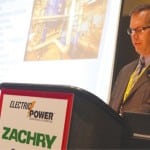NRG Energy will pay $1 million in penalties, install environmental projects worth another $1 million, and complete costly upgrades under a consent decree it entered into with the state of Maryland to resolve wastewater discharge violations at two coal-fired power plants owned by its subsidiary GenOn.
The settlement results from a June 2013 complaint Maryland Attorney General Brian Frosh filed in the U.S. District Court for the District of Maryland seeking civil penalties and injunctive relief to bring NRG’s Chalk Point and Dickerson power plants into compliance with effluent limits.
The twin-unit 710-MW Chalk Point plant is located on the shores of the Patuxent River, and the 546-MW Dickerson plant is located on the shores of the Potomac River. The Patuxent and Potomac Rivers feed into Chesapeake Bay, which is subject to limits for nitrogen and phosphorous that serve to meet applicable water quality standards, the attorney general’s office explained. The two facilities are the largest coal-fired power plants in Maryland.
Million-Dollar Microbes
Between 2009 and 2010, GenOn installed flue gas desulfurization (FGD) scrubbers at the Chalk Point and Dickerson plants, as required by the state’s 2007-enacted Healthy Air Act, and it employed sequencing batch reactors (SBRs) to treat FGD wastewater and water from gypsum collection systems at the plants.
The technology was well established at the time for treatment of municipal sewage, but it had rarely been used to treat power plant waste streams. It essentially uses bacteria, in the form of a sludge bed, that are suspended and cycled between aerobic and anoxic conditions in order to remove nutrients in the wastewater, including nitrogen and phosphorous. The treated wastewater is then filtered to reduce suspended solids before being discharged to surface waters.
Discharge permits issued by the state for Chalk Point in 2009 established annual maximum effluent limitations for total nitrogen equivalent to 329 pounds per year. But just after the plant’s FGD system started operating—and “at various and repeated times thereafter”—the microbes in its wastewater treatment plants died, the consent decree alleges. As a result, Chalk Point vastly exceeded its annual limits for total nitrogen for the most part of the last six years.
While discharge limits for total nitrogen at the Dickerson plant were somewhat more lenient than Chalk Point’s at 511 pounds per year, the plant’s wastewater treatment plant’s microbes suffered the same fate. Dickerson’s nitrogen as well as phosphorous discharges also allegedly exceeded limits for the most part of the last six years.
The consent decree notes, however, that a third GenOn coal-fired plant, the Morgantown electric generating station, stayed in compliance with effluent limits even though it employed the same SBR technology.
Fluid Repercussions
GenOn asserted, as noted by the consent decree, that operational difficulties at the wastewater treatment plants at Chalk Point and Dickerson were complicated by the “extended dispatch-based shutdown periods” stemming from changes in power consumption, cheap natural gas, and “the increased cost of operating the control devices on the coal-fired units.”
The company alerted state regulators of its operational difficulties, even asking in 2010 for both plants’ discharge permits to be reopened for a revision of the annual nitrogen-loading limit. The state admitted that it has not officially acted on the request.
Meanwhile, the company said it has implemented a number of measures to improve the wastewater treatment plants, including modifying capabilities for pH adjustment of the clarifier effluent and using a new stain of microbes that can better tolerate the high chloride levels associated with the FGD waste stream.
Under the consent decree reached by NRG, the state, and several intervenor plaintiffs—including the Patuxent Riverkeeper, Potomac Riverkeeper, and Food & Water Watch—GenOn will now install and operate ammonia, nitrate, and oxygen uptake measurement instruments in the SBR vessels at both plants’ wastewater systems. It will also install and operate membrane ultra-filtration technology at both plants—an upgrade that will cost about $5 million per plant. The latter upgrade will consist of two skid-mounted systems so that one train will be in operation while the second is offline.
Finally, NRG will perform supplemental environmental projects valued at a total of $1 million to benefit the Potomac and Patuxent watersheds. The consent decree requires NRG to submit project proposals to the Maryland Department of Environment for its review and approval in consultation with the environmental intervenors.
The company is pleased to have resolved the lawsuit without further litigation that would be costly and unproductive for both sides, NRG Energy spokesperson David Gaier told POWER on August 30. “Moving forward, we’ll be focused on installing and operating the additional nitrogen control system, and on implementing the supplemental environmental projects that are both key parts of the settlement,” he said.
Maryland, meanwhile, agreed to publish “tentative determinations” to renew the plants’ discharge permits within six months of the consent decree. “The proposed permits will include specific nitrogen limits agreed to by the parties based on historic loading information and the limit of membrane bioreactor technology,” it said.
—Sonal Patel, associate editor (@POWERmagazine, @sonalcpatel)
Correction (Aug. 30): NRG Energy anticipates that installation of a membrane ultra-filtration technology at both plants will cost $10 million, not $3 million as noted by the Maryland attorney general’s office.










